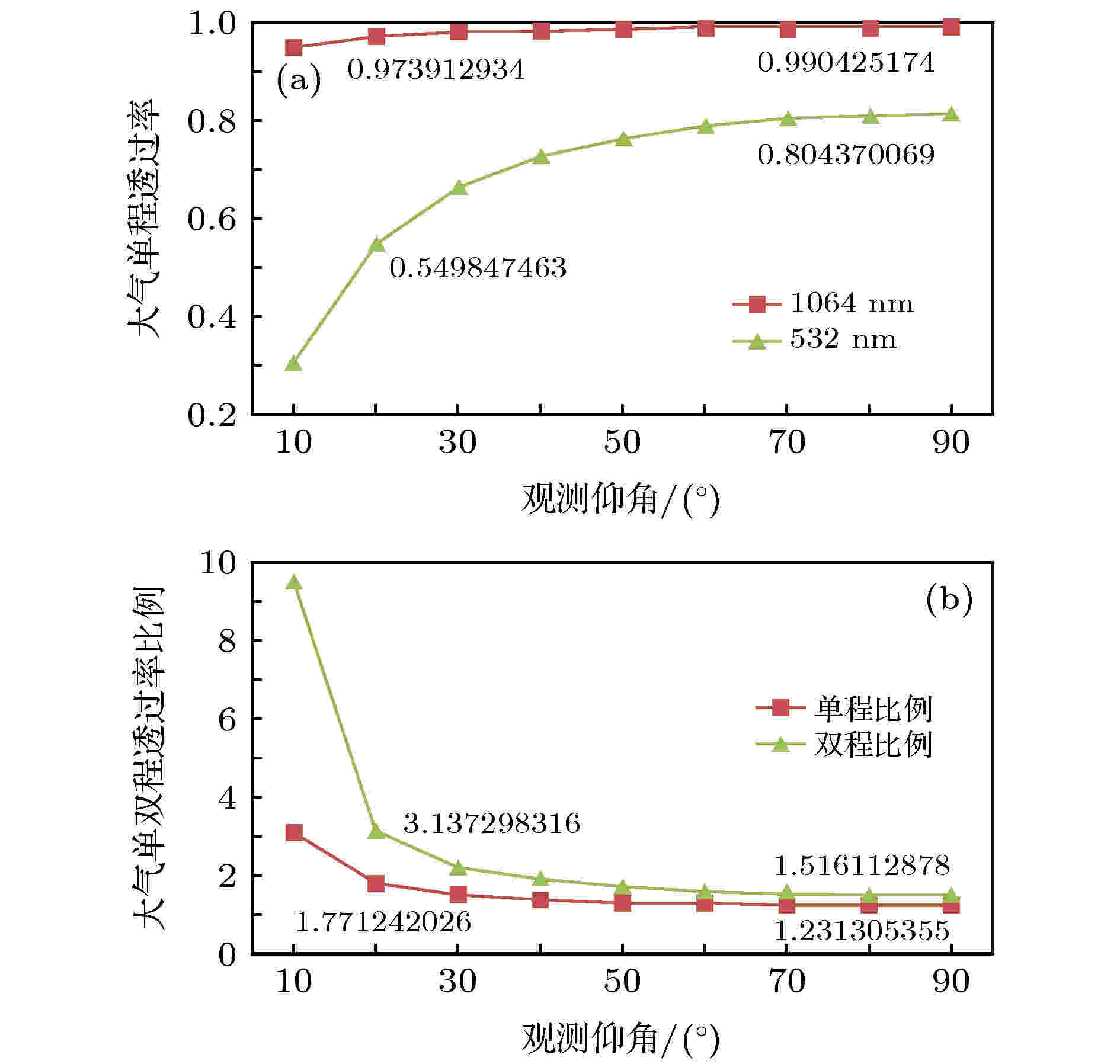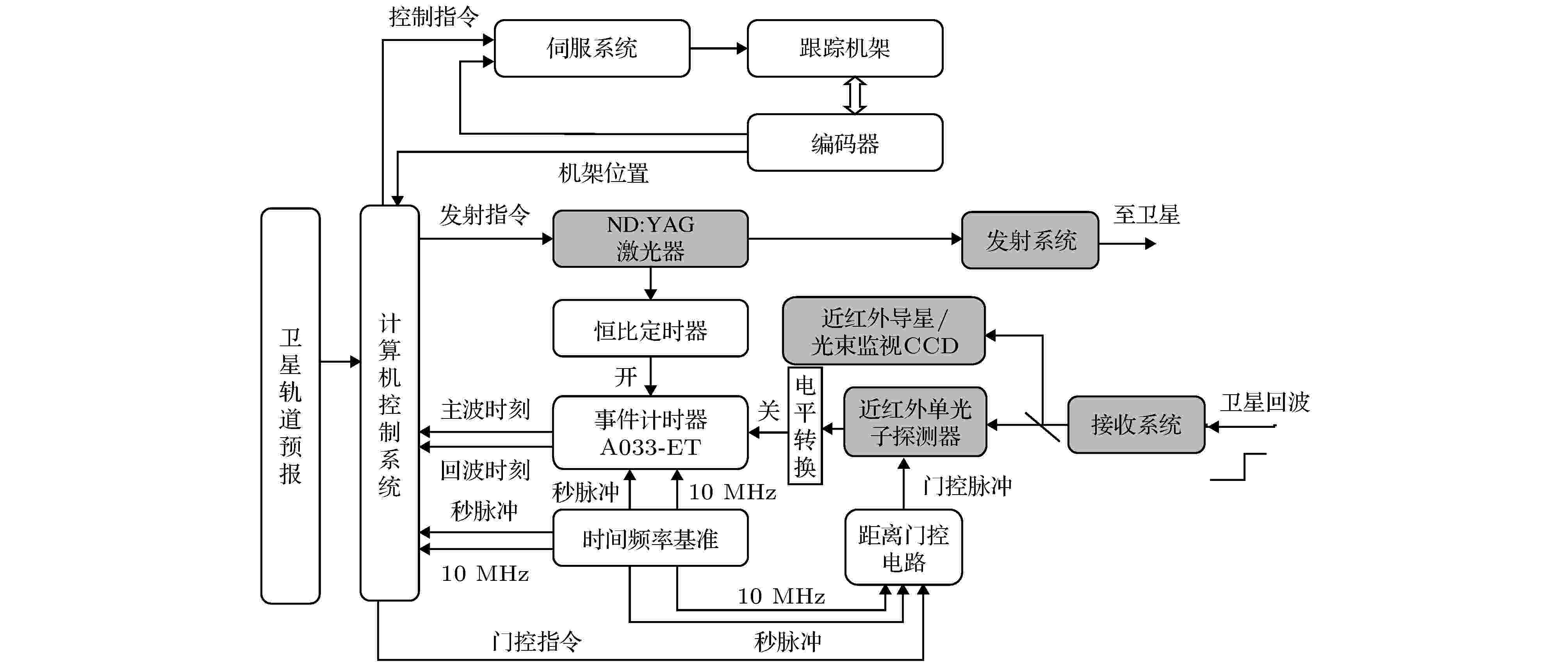全文HTML
--> --> -->目前, 中国科学院上海天文台、云南天文台、长春人造卫星观测站在原有卫星激光测距系统基础上, 使用高功率激光器, 已实现对近距离(500—2600 km)、截面积0.3—20 m2的空间非合作目标激光测距[9-11]. 而对于远距离(> 2600 km)、小尺寸(直径 < 10 cm)的空间碎片测距需采用更大能量、更高质量的激光源以及更大口径望远镜. 常规卫星激光测距采用532 nm波长, 由于卫星端激光反射器的反射效率达到90%以上, 因此地面接收到的光子数较多, 激光处于可见光波段, 光路调试相对容易, 可见光波段的单光子探测技术成熟且效率高, 且532 nm波长激光器技术成熟, 因此大部分卫星激光测距采用532 nm波长. 532 nm激光由1.06 μm激光倍频产生, 由于加入了倍频器件, 其单脉冲能量、功率及稳定度、寿命等均受倍频器件制约, 难以实现较大功率的发射. 相比较而言, 1.06 μm激光器能够获得较大单脉冲能量、功率、稳定度, 该波长的空间背景噪声小于可见光, 且大气透过率也优于532 nm波长, 因此对于传统激光测距台站, 利用1.06 μm波长激光测量是提升系统测量能力的一种经济简单易行且有效的途径.
国际上, 1991年德国Wettzell天文台激光测距站为开展大气折射改正研究, 曾开展过基于1.06 μm和532 nm的双波长激光测距[12], 并成功获得了对LAGEOS卫星的1.06 μm波长激光测距数据. 法国Grasse天文台于2016年对激光器进行了升级改造, 实现了激光测月, 证明了1.06 μm激光测距背景噪声小的巨大优势[13]. 空间碎片激光测距方面, 澳大利亚Mt Stromlo激光测距站采用1.8 m口径望远镜, 使用50 Hz, 100 W的1.06 μm波长激光器成功实现了对尺寸小于10 cm空间碎片目标的测距, 测距精度优于1 m, 获得了良好测量效果[14].
国内研究方面, 2016年云南天文台利用两个完全独立的望远镜分别进行1.06 μm激光发射和接收, 利用40 W激光器和超导纳米线单光子探测器实现了对合作目标的探测, 测距精度约为7 cm[15], 然而其系统较为复杂, 整体效率很低.
本文分析了532 nm和1.06 μm激光测距在激光功率、大气透过率、目标反射效率等方面的差异, 论述了1.06 μm激光用于微弱目标测距的优势; 针对1.06 μm测距系统的难点给出了解决方案, 并对上海天文台532 nm常规激光测距系统进行了改造, 建立了基于InGaAs (Indium-Gallium-Arsenide)探测器的紧凑型收发分离的1.06 μm激光测距系统, 实现了多圈次1.06 μm合作目标及空间碎片激光测距, 这也是国内首次利用InGaAs近红外波段探测器开展的厘米级的1.06 μm高精度高效率激光测距试验.
大气透过率优势: 在激光测距过程中, 大气透过率损耗是一个较大的损耗. 测距观测仰角不同导致的大气厚度差异使得大气损耗产生差异. 大气单程透过率和观测仰角满足如下公式[16]:
 图 1 (a) 1.06 μm和532 nm单程大气透过率随不同仰角变化模型曲线; (b) 1.06 μm和532 nm单双程大气透过率比随不同仰角变化的比例曲线
图 1 (a) 1.06 μm和532 nm单程大气透过率随不同仰角变化模型曲线; (b) 1.06 μm和532 nm单双程大气透过率比随不同仰角变化的比例曲线Figure1. (a) The curve of one-way atmospheric transmissivity at 1.06 μm and 532 nm with different elevation angles; (b) the scale curve of one-way and two-way atmospheric transmissivity at 1.06 μm and 532 nm with different elevation angles.
Degnan[17]于1993年发表的文章中也说明了不同波长的光在观测仰角不同的条件下的大气透过率情况, 1.06 μm波长光在垂直高度上的透过率约为0.991, 532 nm波长光的透过率约为0.815; 在天顶角为70° (对应观测仰角20°)时, 1.06 μm的大气单程透过率为532 nm的1.87倍, 双程透过率为3.5倍, 和公式计算结果基本相符.
单光子探测器: 532 nm波长对应的Si APD (Silicon Avalanche Photodiode)单光子探测器发展成熟, 探测效率超过50%, 并且暗计数和后脉冲噪声低, 但对于1.06 μm波长, Si APD的探测效率仅有3%左右; 而近红外增强型InGaAs APD (Indium-Gallium-Arsenide Avalanche Photodiode)单光子探测器在该波段能获得20%的探测效率[18], 但是由于材料特性和工艺问题, 探测器的暗噪声和后脉冲较大, 为了抑制暗噪声对测量的影响, 探测靶面直径通常小于100 μm, 但仍然适用于单光子激光测距. 超导纳米线单光子探测器在近红外波段探测效率可超过50%[19], 暗计数低, 没有后脉冲影响, 但由于其光纤耦合的特性, 应用于卫星激光测距有一定难度, 上海天文台和云南天文台等单位正在发展基于超导纳米线单光子探测器的卫星激光测距技术[15,20], 已实现对卫星的激光测距, 但其系统庞大, 耦合效率较低, 测距所需成本较高, 目前尚无法大规模开展应用.
目标反射率: 对于大部分常规激光测距角反射器, 其设计波长为532 nm, 对1.06 μm波长的反射效率不做设计, 因此合作目标对1.06 μm波长的反射率通常不如532 nm; 且由于角锥的衍射发散角和波长成正比, 因此合作目标对1.06 μm光反射的面积大, 单位回波强度弱. 但有研究表明对于大部分的空间碎片目标, 其漫反射效率1.06 μm波长反而强度较大[21], 在碎片测距中也可以近似认为和532 nm漫反射效率一致.
太阳光谱强度: 1.06 μm波长的太阳辐照的强度较小, 在地基激光测距中, 海平面高度的太阳辐射强度在532 nm波长为1.37 W·m–2·nm–1, 而在1.06 μm波长则仅有0.62 W·m–2·nm–1[22], 其噪声强度仅为532 nm的45%, 有利于白天测量.
回波光子数和探测概率分析: 根据碎片激光测距的回波光子数公式[17],
(2)式中, 1.06 μm和532 nm波长两者双程大气透过率比值在仰角20°—70°内约为1.52—3.14倍, 假设1.06 μm和532 nm测距系统的光学系统性能相同, 探测器效率相同, 空间目标反射横截面积相同, 采用同一激光器产品, 1.06 μm激光单脉冲能量为532 nm的2倍以上, 则理论上碎片探测时, 1.06 μm回波光子数将达到532 nm回波光子数的6.06—12.55倍.
对于有角反射器合作目标的卫星激光测距, 其光子回波数方程公式[23]为
相比较于碎片回波光子数方程(2)式, (3)式中增加了θs即卫星角反射器发散角的影响, 由于目前大部分激光反射器针对532 nm波长设计, 如采用1.06 μm波长测距, 其发射角将变为532 nm波长的1.3倍, 因此对于合作目标激光测距, 1.06 μm回波光子数是532 nm回波光子数的3.59—7.42倍.
 图 2 上海天文台1.06 μm激光测距系统和改造框图
图 2 上海天文台1.06 μm激光测距系统和改造框图Figure2. Diagram of 1.06 μm SLR system in Shanghai Astronomical Observatory.
其中, 发射和接收系统均镀1.06 μm及532 nm高反或增透膜, 激光器通过移除倍频晶体或将输出激光分束输出的方式实现. 由于针对可见光的单光子探测器在近红外波段效率不高, 我们采用了由盖格模式InGaAs APD器件研制的1.06 μm波段增强的单光子探测器, 该探测器探测效率和时间抖动分别大约为20%和70 ps. 对于导星和光束监视, 由于1.06 μm波长的大气后向散射十分微弱, 因此对低功率激光发射的合作目标激光测距, 我们利用全反射镜将望远镜接收的全部1.06 μm光送入近红外CCD来进行光束成像, 并通过全反镜的平移使得回波在光束监视和光子探测两种模式间切换, 完成测距操作, 其中光束平移镜实现了优于1"的平移精度; 对于高功率激光发射的碎片测距, 则采用分光镜将部分接收光送入CCD用于监视, 大部分光进入光子探测器进行测距, 此时激光的光束监视和回波接收可以同时完成.
 图 3 1.06 μm激光测距系统光尖监视图
图 3 1.06 μm激光测距系统光尖监视图Figure3. Monitoring picture of the light-cone in 1.06 μm laser ranging system.
在合作目标卫星激光测距中, 532 nm波长的Si APD单光子探测器的探测效率约为20%, 时间抖动约为25 ps; 1.06 μm波长的InGaAs APD单光子探测器探测效率也约为20%, 时间抖动约为70 ps. 我们在2016年7月前后采用InGaAs APD单光子探测器, 利用1.06 μm波长对轨道高度400—36000 km合作目标成功开展了高精度测距, 这也是国内首个利用近红外InGaAs探测器实现的高精度高效率的1.06 μm合作目标激光测距试验.
1.06 μm合作目标激光测距的结果如表1所列, 同时我们也将观测仰角类似的同类型卫星的532 nm常规观测数据进行比对. 对于大部分相同类型的卫星, 1.06 μm的测量效率均比532 nm有较大程度的提高; 而由于激光器倍频晶体、角反射器综合发散角、以及较为主要的单光子探测器精度的影响, 1.06 μm测距精度略差. 在系统噪声方面, 1.06 μm则表现出了明显的测距优势.
| 圈次 | 仰角均值/(o) | 轨道高度/km | Point | 测距精度/mm | 回波率 | 噪声密度/个·s–1·m–1 | |
| 1.06 μm | |||||||
| 16072019.LES | 37 | 1450 | 7641 | 20.5 | 18.64% | 0.622 | |
| 16072019. G1 | 48 | 35786 | 489 | 14.9 | 0.15% | 0.498 | |
| 16072020.G18 | 56 | 19140 | 9668 | 33.1 | 1.83% | 0.680 | |
| 16072020.G17 | 51 | 19140 | 715 | 31.7 | 0.22% | 0.700 | |
| 16072019. I7 | 51 | 35786 | 3325 | 18.9 | 1.44% | 0.646 | |
| 16072018.G02 | 65 | 19140 | 9798 | 23.6 | 5.10% | 0.583 | |
| 532 nm | |||||||
| 17091802.LES | 37 | 1450 | 1037 | 6.4 | 3.99% | 6.574 | |
| 17091715.G1 | 48 | 35786 | 1713 | 10.5 | 0.14% | 8.114 | |
| 17082218.G18 | 54 | 19140 | 4375 | — | 0.75% | — | |
| 17082318.G17 | 51 | 19140 | 1323 | 13.8 | 2.32% | 1.126 | |
| 17072720.I5 | 51 | 35786 | 1302 | 12.3 | 0.30% | 1.616 | |
| 17072216.G02 | 65 | 19140 | 3026 | 11.7 | 0.37% | 6.015 |
表12016年合作目标激光测距1.06 μm和532 nm波长测距结果和比对表
Table1.The comparison table of cooperative target laser ranging at 1.06 μm and 532 nm.
对于碎片目标而言, 由于回波信号较弱, 通常采用大功率激光器进行测距, 激光后向散射强度很大, 仅利用望远镜采集的部分光即可实现对光尖的监视; 利用上述系统, 通过光路中镜片的更换, 我们实现了同时对空间碎片测距的光尖监视和回波测量功能, 使得碎片测距更直观易行. 利用这套系统于2016年8月进行了针对空间碎片目标的观测, 测距界面如图4所示. 测距目标为距离1500 km左右的火箭残骸, 目标大小为13.2 m2; 激光器输出波长为1.06 μm, 重复频率为200 Hz, 激光功率为40 W, 脉冲宽度为5.5 ns. 本次空间碎片测距的测量效率为3.7%, 测距精度约为1.6 m.
 图 4 1.06 μm开展碎片激光测距实时测量界面截图
图 4 1.06 μm开展碎片激光测距实时测量界面截图Figure4. Screenshot of real time 1.06 μm debris laser ranging measurement interface.
由于空间碎片测距过程中后向散射较为强烈, 而InGaAs APD单光子探测器光损伤阈值小, 此次空间碎片测量完成后, InGaAs APD器件损坏. 随后, 开展了对探测器的修复工作, 同时设计了一套新的后向散射规避系统, 进行了测量终端箱及激光发射系统的改造.
2019年1月, 利用1.06 μm波长开展激光测距的试验再次开展, 此次测量中系统激光功率为532 nm波长0.7 W, 1.06 μm波长1.2 W; 系统收发效率分别为532 nm波长55%和60%, 1.06 μm波长47.7%和57.2%, 两个波长的收发效率基本相同. 这次试验重点开展的是同样条件下对相同目标的比对测距, 主要目标为远距离的地球中高轨道合作目标. 选取了多颗我国北斗(BDS, Beidou Navigation Satellite System)及俄罗斯格洛纳斯(GLONASS)导航卫星进行了两种波长的比对性测距, 试验情况如表2所示.
| 圈次 | 组别 | 仰角均值 | 轨道高度 | 点数 | 测量时长 | 测距精度 | 回波率 | 噪声密度 |
| /(o) | /km | /min | /mm | /个·s–1·m–1 | ||||
| 1901171707.G121 | G121-1064-2 | 45 | 19, 140 | 1542 | 1.2 | 23.2 | 2.142% | 0.523 |
| G121-532-1 | 45 | 380 | 2.1 | 20.1 | 0.302% | 3.36 | ||
| 1901171719.I5 | I5-1064-B-1 | 53 | 35, 786 | 96 | 0.783 | 21.4 | 0.204% | 0.65 |
| I5-532-2 | 55 | 137 | 2.283 | 16 | 0.1% | 3.24 | ||
| 1901171744.G1 | G1-1064 | 49 | 35, 786 | 450 | 2 | 11.5 | 0.381% | 0.51 |
| G1-532 | 49 | 145 | 2.217 | 7.9 | 0.109% | 3.15 | ||
| 三组数据分别为对俄罗斯Glonass-121卫星, 中国北斗IGSO-5卫星, 中国北斗GEO-1卫星的观测数据, 每组数据的第一行为利用1.06 μm波长的测距结果, 第二行为利用532 nm波长的测距结果. | ||||||||
表22019年合作目标导航卫星激光测距1.06 μm和532 nm波长测距结果和比对表
Table2.The comparison table of navigation satellites laser ranging at 1.06 μm and 532 nm in 2019.
本次测距采用修复后的InGaAs单光子探测器, 其探测效率和532 nm单光子探测器效率相当, 测距系统对两个波长的收发效率类似; 试验在同一台激光测距望远镜上利用不同波长先后对同一颗卫星目标进行了测距, 在观测环境和系统情况相似的条件下, 1.06 μm波长测距相对于532 nm波长测距, 三圈不同的中高轨卫星观测时天空的背景噪声比值分别为1/5.02, 1/6.40及1/6.12, 天空背景噪声强度显著降低; 测距回波效率倍率分别为7.1, 2.0和3.5, 测距回波效率增强明显.
此次对合作目标的比对测试利用1.2 W的1.06 μm激光器实现了对地球同步轨道卫星的近红外波长测距, 比532 nm波长回波效率最高提升至7倍, 而天空背景及暗噪声的综合影响仅为532 nm波长的1/5, 进一步明确了1.06 μm波长在远距离微弱目标探测中的优势.
在测距精度方面, 此次1.06 μm波长的表现略差, 主要影响因素有如下方面: 同一台激光器倍频前后激光脉冲展宽差异, 这方面的差距可以在今后使用的激光器研制过程中予以要求和控制; 目前测距的合作目标均为按532 nm波长测距设计, 其中二面角特性对于1.06 μm波长展宽较多, 在一定程度上影响1.06 μm测量精度, 今后对于高精度需求的远距离微弱目标, 可针对1.06 μm波长进行合作目标设计, 可以将此方面影响降到最小; 目前采用的InGaAs单光子探测器测量精度约为70 ps, 相对于532 nm常规使用的Si APD探测器的25 ps有差异.
未来通过对上述问题的研究和解决, 利用本文目前经典的紧凑型收发分离的单台激光测距望远镜, 可以更便捷、低成本地实现对远距离微弱目标的近红外波长高精度测量, 获得测量能力的较大幅度提升, 同时几乎不增加测量系统的观测复杂度和难度.
对于空间碎片测距而言, 1.06 μm波长可以更容易实现激光发射能量和功率的提升, 系统性能更加稳定, 非常有助于提高碎片测量能力; 1.06 μm波长回波光子数多的特性有利于开展对更远、更小碎片目标的探测; 而整个测量系统低噪声的特点则有利于预报精度较差的空间碎片目标的搜索, 也更有利于未来开展白天空间碎片激光测距的技术研究; 本文实现的基于InGaAs APD单光子探测器的1.06 μm空间碎片激光测距系统还具有系统紧凑、小改动、易操作、低成本等特点, 更有利于系统新建或对现有激光测距望远镜的改造, 进而建立较大规模的碎片激光测距网, 开展针对距离更远或尺寸更小的空间碎片目标的联合观测; 而未来1.06 μm探测器测量精度的提升则为开展厘米尺度空间碎片激光测距提供了可能, 对小尺寸碎片目标的高精度测距定轨, 和空间碎片目标的高精度态势分析和研究具有重要意义.
感谢国防科工局项目为本文工作的开展提供指导和支持.
